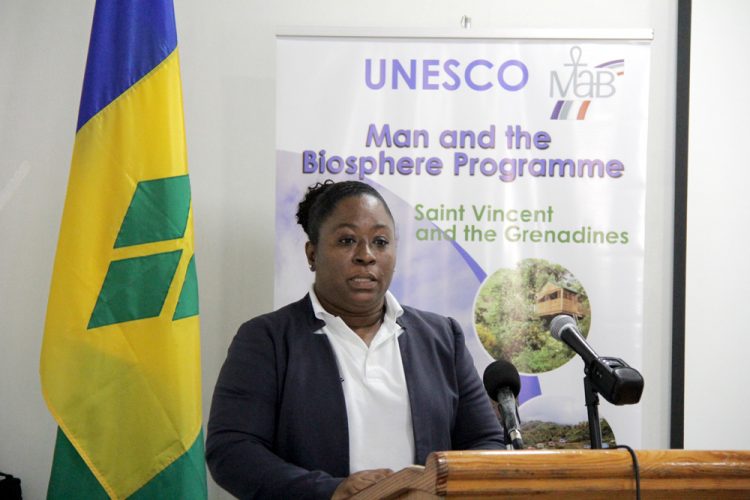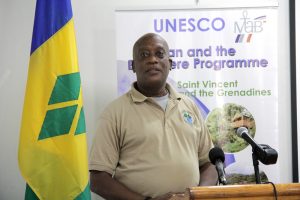MAB project seeks UNESCO designation for Buccament Valley (+ Video)

A project encompassing the 13 communities making up the Buccament area — Rilland Hill to Buccament Bay, inclusive of Vermont — could see St Vincent and the Grenadines (SVG) joining the 131 countries around the world that have biosphere reserves.
“The Holistic Management and Sustainable Development of the Buccament Valley Biosphere Reserve” project was launched in Kingstown, on Monday February 21, under the UNESCO Man and the Biosphere (MAB) programme.
Janeil Henry-Rose, secretary general, SVG National Commission for UNESCO, said that the MAB programme aims to achieve a better and more sustainable future.
“So, the interaction of humans with their environment and how we must keep the environment well preserved for future generations.”
She said that the programme addresses challenges experienced in various ecosystems, such as climate change and biodiversity loss.
“It zeroes in on communities, different environments, habitats, the social issues, natural issues in the environment … All these things are taken into consideration, and, importantly, too, the economics of the community, of the country, and the place and education of particular locale, the particular environment.
“So, it combines all these elements to improve the livelihoods of the people to safeguard and also to manage the whole ecosystem and the environment and to have equitable sharing of the benefits from the particular environment.”
Henry-Rose said that SVG continues to play its part in ensuring that the environment is properly maintained for generations to come.
She said that getting the “UNESCO Biosphere Reserve” designation could take between one and 10 years. “It depends on the stakeholders… It is how fast we work, how we get our stakeholders involved and how we press on with this project. So, it is up to us, basically.”
Vincent Reid, a member of the local MBA committee, said:
“When we were made aware of this programme, we started looking at what is the best fit for a biosphere reserve. We looked at all the criteria and thought of what part of St. Vincent can best meet all of them. And we thought that the Buccament Valley would be the best fit.”
In giving an overview of the Buccament Valley watershed, Casmus A. McLeod, the local focal point to UNESCO on MAB issues, said the project would help residents to recognise the importance of the area.
“Our intention would be to get the community to realise the asset that they have because, sometimes, we do have assets and don’t realise that we have them and to realise the potential that the area has and to get great community buy-in.”

He said that groundwork has been started in the community and residents are eager to become involved, having seen the economic potential of having the area as a biosphere reserve.
“… and also they are interested in the sustainable use and the protection of the area, hence the reason we are here to get the process going the right way,” McLeod further stated, adding that with integrated water resource management comes inclusion.
“And not inclusion at the middle or the finishing stage but at the inception and all along the way. We plan to make sure that persons are involved and aware of what we are hoping to achieve.”
He said that the project leaders are soliciting ideas from residents of the community.
“We have already been getting some great ideas from community persons and that would … be incorporated into the overall management plan for the area and future intervention.”
McLeod said that having an area declared as a biosphere reserve gives it certain priority and push.
“For example, when this area becomes a biosphere reserve, it is going to be internationally recognised, which is something we are interested in having, of course, because that is very important.”
He said that an area has to be nominated by the government in order to be declared a biosphere reserve.
“… this is an area here that is going to have the blessing of the government,” he said, adding that even with a UNESCO biosphere reserve declaration, an area remains under the sovereign jurisdiction of the state.
He noted that the Buccament Valley, which is located in western St. Vincent, extends from an upland mountainous region down to the shoreline of Buccament Bay, and includes 10 villages in the upper and mid valley and three lower valley communities.
The constraints include high unemployment and low educational levels.
McLeod, however, pointed out that the valley is noted for agriculture, housing and tourism. It also has schools, a polyclinic, a resort, and fishing on the coast.
He said that the area is important as it is home to some of the nation’s key biological species, including the national bird, the whistling warbler, the whistling frog, and the black snake, which are all endemic to SVG.
Once the area is declared a biosphere reserve, it would have international recognition, McLeod said.
“The persons in the areas are going to have a greater sense of ownership and we are going to be looking into the various resources and see how much we can create new alternative livelihood opportunities.”
He said there is an abundance of resources in the area. “But we are now going to look at how persons can benefit from the resources,” McLeod said, mentioning, as an example, training tour guides to operate at the Vermont Nature Trail.
Three meetings will be held, beginning next week, to further sensitise residents about the project.
The World Network of Biosphere Reserves currently counts 727 sites in 131 countries all over the world, including 22 transboundary sites.









